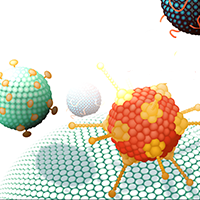Scaling up gene therapy manufacturing for multinational pivotal trials & commercialization
Cell Gene Therapy Insights 2018; 4(10), 1015-1018.
10.18609/cgti.2018.100

Krzysztof Regulski, PhD, is a CMC Manager at GenSight Biologics. He manages CMC activities and leads Process Development of GS030 Product associated to optogenetic therapy for retinitis pigmentosa. He has been working in biotechnology industry since 2007, having experience in Bioprocess and QC Methods Development & Validation, Technology Transfer to CMO’s and Project Management. Before joining GenSight Biologics, Dr. Regulski was formerly Head of Bioprocess and Analytical Development at Pherecydes Pharma (Romainville, France). He received his Master’s degree in Industrial Biotechnology from Poznan University of Life Sciences (Poland) and a PhD in Biochemistry and Microbiology from University of Paris-Sud (France).
Can you give us some background on GenSight Biologics’ platform AAV vectors?
KR: GenSight Biologics has taken a very collaborative approach to licensing and developing the technologies of interest to us. We have established several strategic collaborations – mainly with the Institut de le Vision in Paris, which specialises in eye disease. We also work with several academic partners in the gene therapy field.
Our AAV vectors currently in clinical application – GS010 and GS030 – have now been optimised for specific tissue infectivity and are ready for processing in the industrial setting.
As a biotech with multiple Phase 3 studies underway, GenSight Biologics has more experience than most in scaling up manufacture towards commercial levels – can you tell us about the company’s approach to this challenge?
KR: Gene therapy products for ocular diseases are administrated by intravitreal injection and the required dose volumes are typically small. This obviously provides a clear advantage in terms of the required scale of production.
GenSight uses both major systems for AAV production – mammalian cells and insect cells – but our general recommendations are the same for each one.
First of all, critical starting materials must be secured and qualified according to GMP guidelines at as early a stage as possible. This preference for using GMP starting materials – for example, cell banks, viral banks and raw materials – at an early stage of one’s process development might not be immediately evident. However, it can provide some clear advantages later on – when demonstrating batch comparability, for example.
It’s also important to focus on demonstrating the consistent quality of the drug product, starting from preclinical production and continuing through Phase 3 to commercial batch production – this is vital in order to avoid the risk of having to return to the lab for re-testing. In our experience, these early stage quality as well as stability studies are also very supportive in helping determine the shelf life of clinical trial batches.
As AAV-based gene therapy continues its emergence as a commercial therapeutic reality, CMC challenges – and solutions – continue to come to the fore. What are the key remaining issues that you face in this regard, and how are you seeking to address them?
KR: The fact that our products target rare eye diseases – Leber hereditary optic neuropathy (LHON) and retinitis pigmentosa – means we are dealing with relatively small starting patient populations. On the one hand, this means that the frequency of batch manufacturing is fairly low. On the other, though, we are working in a field where manufacturing technology and regulatory guidelines are constantly evolving. It is therefore particularly important for us to keep an eye on regulatory change and anticipate future developments and agency recommendations, so that we can rapidly adapt our manufacturing strategy when required.
At the late clinical and commercialisation stages, all QC testing must be validated, of course, and this can be a challenging area for gene therapy products – development and GMP validation of specific potency assays is one particular example. In addition, given the inherent complexity in manufacturing biological products to the same level of quality, the lack of clear standards in this regard remains an issue.
How do you approach the challenges in meeting diverse regulatory requirements – for instance, in producing vectors for the simultaneous US and European pivotal studies?
KR: Firstly, we adhere to quality control testing guidance from two pharmacopeias – the US and the European – and we work with highly specialised laboratories for certain specific tests because, in gene therapy, it is vital to access that degree of know-how and expertise in complex analytical methods. We also follow ICH guidelines – for example, regarding stability studies.
With emerging drug products such as gene therapies, regulatory bodies may well request additional testing. Our response to this potential challenge is to store internal process controls so that we can respond quickly in that event.
And finally, right from the beginning of any regulatory submission, it’s obviously very important to be open with the regulatory agencies and willing to discuss potential issues with them in a transparent way.
What will be the next steps in terms of developing a robust, global supply chain for GenSight Biologics’ therapeutics?
KR: In general, the global supply chains for GenSight’s products will be developed as the clinical trials proceed: our initial focus is on those markets where the early regulatory submissions will be made – the US and the European Union – and in order to define supply chain requirements, we need to be able to forecast demand for the given product in each region. This forecast is in turn determined by the clinical data as the trials continue, as it is these results which clarify the target patient population.
In parallel to this, we will seek to gain insights from market assessment studies, and we will work with the clinical investigational sites to help determine the network of centres at which patients will be treated commercially.
The CMC team defines the steps required to move from clinical scale batches to commercial batches. This process will involve GenSight finding the right partners for the manufacture and distribution of the product to the relevant clinical centres.
GS030 is in Phase 1/2 trials at the moment, so the supply chain focus for that product is all about simply ensuring that adequate supplies reach the clinical trial sites in a timely fashion. Because GS010 is more advanced in its clinical development programme, though, its global supply chain model is better defined. Moving forward, the GS010 supply chain will be augmented to cover new markets as and when the market application dossiers are submitted.
Affiliation
Krzysztof Regulski
CMC Manager at GenSight Biologics
